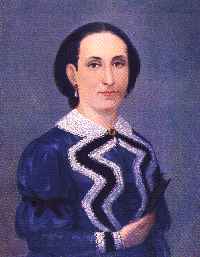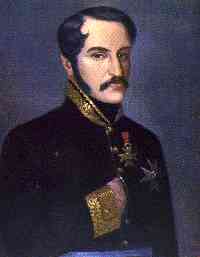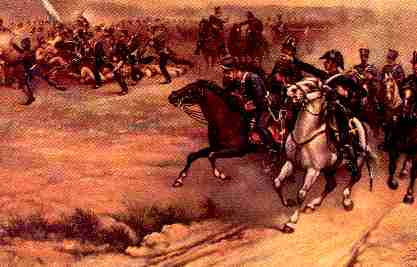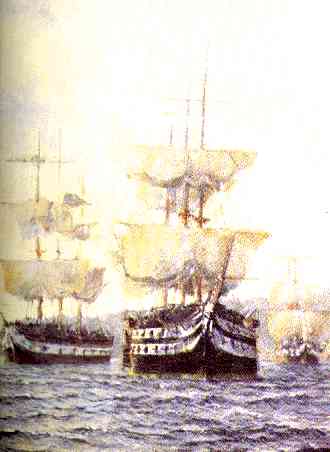Summary:
|
San Martin was born in Yapeyu, in the Argentine province of Corrientes, beside the mighty Uruguay river, on February 25th 1778. |

| His father, Don Juan de San Martin, was the governor of the department; her mother, Doña Gregoria Matorras, was the niece of a conqueror of the Chaco´s wild forests |
 |
In 1786 he is transferred to Spain with his family, where
he studies in the Noble Seminary of Madrid and, in 1789,
he initiates his military career in the regiment of Murcia. he
serves in the army of Spain during the wars against the French and in
1808 he fights in the battle of Baylen against
Napoleon´s army that had invaded the Peninsula. The United Argentine-Chilean army recovers and on April 5th
they defeat completely the Spanish army in the battle of Maipu. That battle ended
the Spanish efforts to dominate Chile.
On August 20, 1820 the expeditionary Argentine-Chilean army
sails from the port of Valparaiso to Peru.
In the month of July, 1821, San Martin enters triumphant to the city of Lima, proclaims independence, is designated Protective of Peru and exerts the government.
On September 20 of that year meets in Lima the first Congress of Peru and there the Protective resigns to his office. The same day he embarked for Chile and months later crosses the Andes to Mendoza.
In the city of Cadiz he knows other South American officers and he
joins the lodges that promoted the independence. In 1811 he
resigns his military career in Spain and embarks in the sail ship George Canning from England to Buenos Aires, where he arrives the 9 of March of 1812 accompanied by other friends.
The independent government of Buenos Aires accepts the
services of San Martin, recognizes his degree of lieutenant colonel
and orders him to create a cavalry corps that soon would be the
glorious regiment of Mounted Grenadiers. In that same year he married Maria Remedies de Escalada, that belonged to a distinguished family of the country. He creates the Lautaro lodge, whose objective was to liberate South America of the Spanish yoke. In October of 1812, the members of the lodge head a movement that
intends to remove some members of the First Triunvirato (the government). Pacifically, the Town Hall names a Segundo Triunvirato, who, soon
after, calls to an Assembly of Delegates of the Provinces with the
purpose of dictating a Constitution.
In January of 1814, San Martin takes control of the North
Army, from the hands of its former general, Belgrano, that had returned defeated from the Alto Peru -today the republic of Bolivia-, and since then, they establish a long friendship.
Soon after being San Martin in Tucuman, he realized that it was impossible to conquer Lima city, the capital of Peru, that was the center of
the Spanish power, by the terrestrial way of the highs of the Andes. He conceived the idea of crossing the mountain range to Chile and to attack the city of Lima by sea way.
A disease forces him to request license and obtains from the government the nomination of Governor of the Cuyo province. He leaves Tucuman for Mendoza, capital of Cuyo, a city that stands at the foot of the mountain range of the Andes. There he recovers and begins to prepare an army to cross the Andes.
In the year 1816 he sends, representing the province of Cuyo, a delegation to the congress that met in Tucuman, with express orders to insist on the
declaration of independence. Because of his insistence, the declaration of the independence from the rule of Spain of the Provincias Unidas del Rio de la Plata -that was the primitive name of what now is the Argentine Republic- was acclaimed in that congress the 9 of July of that year.
From Mendoza he prepares with little means an army. All the
people contributes with their work and goods to make the dangerous
expedition. He insists before the government of Buenos Aires to
permit to his army the crossing of the Andes to Chile.
On February 12, 1817 few days after the passage of the
Andes, the army, that was given the name "Army of the Andes", wins the
battle of Chacabuco and some days after, the Liberator enters the city of
Santiago de Chile. The Town hall met the day 18th and designated San Martin
Supreme Director, but he resigned that honor and then general
Bernardo OHiggins was elect for the position.
In the first days of 1818, a disembarked realistic army from
Peru, advanced on the capital of Chile. The 19 of March, in a night
attack, the Spanish army defeats the independents in the battle of
Cancharrayada and general OHiggins was wounded.

The way to Lima by sea was then opened, but it was necessary to
create a fleet that did not exist. With some boats captured to the enemy
and others bought to the United States and England, the Chilean navy was
created. The first admiral was Blanco Encalada and then took command the English admiral, Lord Cochrane.
